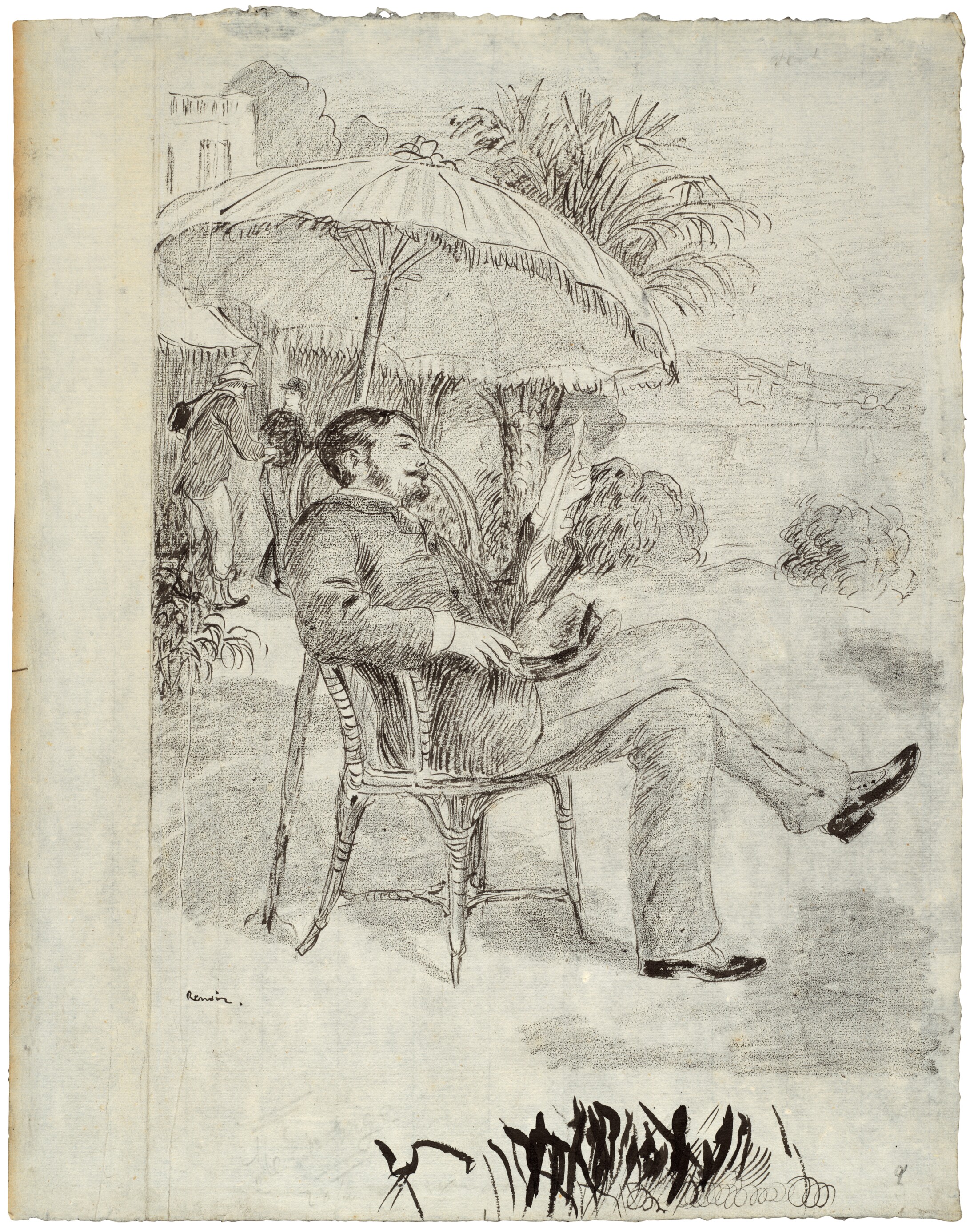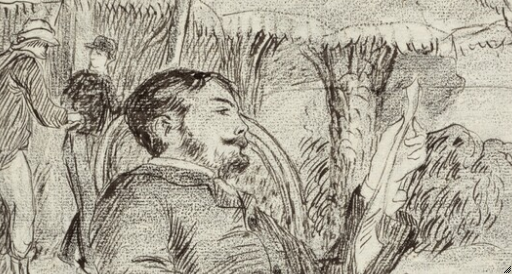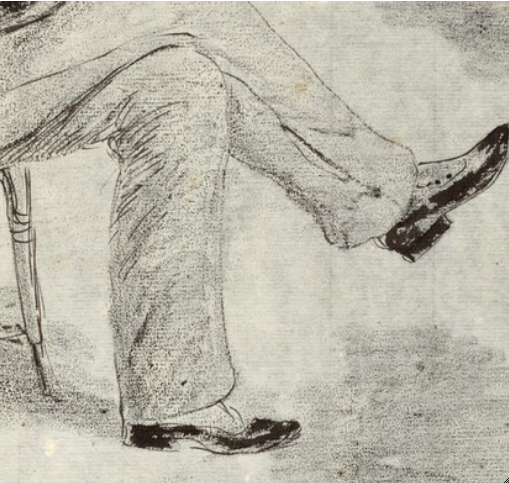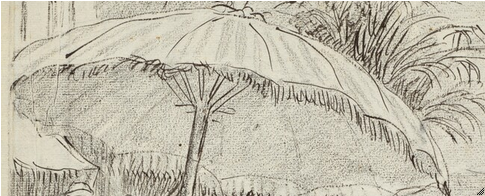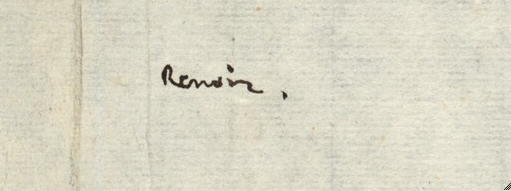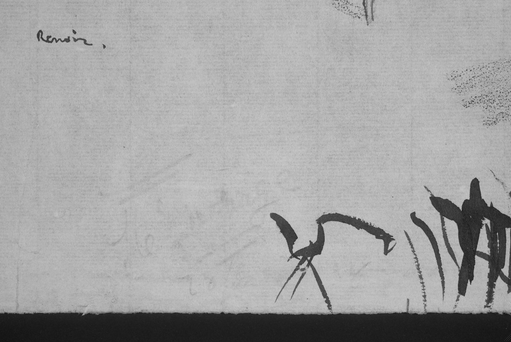Cat. 12
On the Terrace of a Hotel in Bordighera: The Painter Jean Martin Reviews His Bill (Illustration for Edmond Renoir’s “L’étiquette”)
1881
Conté crayon, over pen and brush and black ink, on ivory laid paper, discolored to cream; 452 × 354 mm
Signed: Renoir (recto, lower left, in pen and black ink)
The Art Institute of Chicago, Helen Regenstein Collection, 1977.491
Technical Report
Technical Summary
Renoir applied his drawing media in a variety of ways to create On the Terrace of a Hotel in Bordighera: The Painter Jean Martin Reviews His Bill (Illustration for Edmond Renoir’s “L’étiquette,” almost completely covering the surface of the ivory-colored [glossary:laid] paper. The compositional lines were worked out primarily in pen and black ink. Fine, delicate lines were used to render the sitter’s delicate facial features and impart the delicate grasp of the bill in his hand (fig. 1.2). In other areas, slightly thicker lines spaced closely together or hatched create shading and tonal passages. Renoir employed brush and black ink to create dark passages in the sitter’s shoes, hair, and hat (fig. 1.1); in the upper left figure’s bag; and in the foreground grass.
The artist then applied [glossary:Conté crayon] to form medium tonal passages in the sitter’s clothing and in the underside of the umbrella as well as to create a sense of depth (fig. 5.11). The Conté crayon picks up the moderate surface texture of the paper, creating a grainy appearance in the tonal passages. Renoir introduced highlights into the composition by leaving the light tonality of the paper exposed in the building facade at the upper left, in the top of the umbrella, and in the foreground, creating the illusion that light is striking these surfaces. The left margin of the sheet is devoid of media and appears to have been formerly folded behind the sheet early on in the drawing’s execution.
Signature
Renoir (recto, lower left, in pen and black ink) (fig. 1.3).
Media and Support
Support Characteristics
Primary paper type
Ivory (discolored to cream), medium-thick, moderately textured laid paper.
Chain line orientation and frequency
Vertical, 2.7–2.8 cm.
Laid line frequency
9–10 cm.
Furnish
Uniform, without significant inclusions or colored fibers.
Formation
Even, possibly machine made.
Other characteristics
[glossary:Deckle edges] are present along the right side, and top and bottom edges; the left edge is cut straight.
Dimensions
452 × 354 mm.
Preparatory Layers
No artistic surface alterations or coatings are visible in normal conditions or under magnification. Under [glossary:UV] illumination, there is a pale-yellow visible-light [glossary:fluorescence] overall on the paper surface that is characteristic of a light gelatin surface [glossary:sizing].
Media Characteristics
Pen and brush and black ink were used to create the compositional lines, over which Conté crayon was applied to establish broad tonal areas.
There is no drawing on the verso. Two spots of black ink are present in the center left area.
Compositional Development
No revisions or changes are visible in the composition in normal conditions or under magnification.
Surface Treatment
No artistic surface fixatives or coatings are visible in normal conditions, under UV illumination, or under magnification.
Condition History
The drawing is in relatively good condition overall. The paper [glossary:support] has discolored slightly overall, though it is darkest along the left edge. The paper appears to have been formerly folded along the left margin, forming a crease approximately 5.2 cm from the left edge. It is likely that the fold was created at the time the work was drawn, as there is some accumulation of media along the crease. A fine irregular fold in the paper extends from the left bottom edge up through the image area, terminating just before the top edge. This fold also existed early on, possibly developed after the sheet’s formation; media accumulation is visible at the high points along the fold.
On the verso, in the center left area, there are two spots of black ink that appear to be similar to the drawing medium. These are visible through to the recto when the sheet is placed against a light surface; to minimize or reduce the visibility of these spots, the drawing is hinged against black rag matboard. The work does not appear to have undergone conservation treatment in the past.
Kimberly Nichols
Provenance
Charlotte Labille (1889–1963), Paris, by Jan. 1, 1925.
Paul Rosenberg (1881–1959), Paris and Bordeaux, by Sept. 15, 1940.
Confiscated from Paul Rosenberg, Bordeaux, by the Einsatzstab Reichsleiter Rosenberg (ERR), Sept. 15, 1940.
Selected by Walter Andreas Hofer (1893–c. 1971) at the Jeu de Paume, Paris, for Hermann Goering (1893–1946) and transferred from the ERR to Goering, Dec. 2, 1941.
Exchanged by Hermann Goering, with Hans Wendland (born 1880) and Theodor Fischer (1878–1957), Lucerne, via Walter Andreas Hofer, early 1942.
Returned to Paul Rosenberg, New York, June 3, 1948.
Probably sold by the Rosenberg family to E. V. Thaw and Company (founded 1950), New York, c. 1977.
Sold by E. V. Thaw and Company, New York, to the Art Institute of Chicago, 1977.
Exhibition History
Art Institute of Chicago, Great Drawings from The Art Institute of Chicago: The Harold Joachim Years, 1958–1983, July 24–Sept. 30, 1985, cat. 71 (ill.); Saint Louis Art Museum, Mar. 10–May 16, 1986.
Art Institute of Chicago, Masterpieces from the Helen Regenstein Collection, Feb. 2–May 8, 1990, no cat.
Art Institute of Chicago, Maineri to Miro: The Regenstein Collection, Apr. 22–July 16, 2000, no cat.
Vienna, Albertina, Impressionism: Pastels, Watercolors, Drawings, Feb. 9–May 13, 2012, pl. 137.
Selected References
Edmond Renoir, “L’étiquette,” La vie moderne 50 (Dec. 15, 1883), p. 803 (ill.).
Georges Rivière, Renoir et ses amis (H. Floury, 1921), opposite p. 192 (ill.).
Charles Léger, “Renoir illustrateur,” L’art vivant 168 (Jan. 1933), p. 8 (ill.).
John Rewald, “Auguste Renoir and His Brother,” Gazette des beaux-arts 27 (Mar. 1945), pp. 172, no. 2 (ill.), 186.
John Rewald, Renoir Drawings (H. Bittner, 1946), p. 18, no. 24 (ill.).
Walter Pach, Renoir (Abrams, 1950), p. 20 (ill.).
Phoebe Pool, Impressionism (Oxford University Press, 1969), pp. 152, no. 114 (ill.), 153, 277.
Walter Pach, Auguste Renoir: Leben und Werk (M. Dumont Schauberg, 1976), pp. 72, no. 42 (ill.), 73, 173.
Harold Joachim and Sandra Haller Olsen, French Drawings and Sketchbooks of the Nineteenth Century, vol. 2 (University of Chicago Press, 1979), p. 90, no. 5D7.
Nicholas Wadley, Renoir: A Retrospective (Hugh Lauter Levin, 1987), p. 130 (ill.).
Natalia Brodskaya, Auguste Renoir: He Made Colour Sing (Parkstone, 1996), p. 33 (ill.).
Douglas W. Druick, Renoir, Artists in Focus (Art Institute of Chicago/Abrams, 1997), pp. 41, 44, 90, no. 9 (ill.), 110.
Martha Tedeschi, “Pierre Auguste Renoir, Workers’ Daughters on the Outer Boulevard (Illustration for Emile Zola’s ‘L’Assommoir’), 1877/78,” in “Maineri to Miró: The Regenstein Collection since 1975,” special issue, Art Institute of Chicago Museum Studies 26, 1 (2000), pp. 80–81, no. 35 (ill.).
Suzanne Folds McCullagh, “‘A Lasting Monument’: The Regenstein Collection at the Art Institute of Chicago,” special issue, Art Institute of Chicago Museum Studies 26, 1 (2000), p. 13.
Guy-Patrice Dauberville and Michel Dauberville, with the collaboration of Camille Frémontier-Murphy, Renoir: Catalogue raisonné des tableaux, pastels, dessins, et aquarelles, vol. 1, 1858–1881 (Bernheim-Jeune, 2007), p. 621, no. 672 (ill.).
Other Documentation
Inscriptions and Distinguishing Marks
Recto
Mark
Location: bottom left area
Method: graphite or chalk erased, faintly visible in normal conditions and infrared radiation
Content: [illegible] (fig. 1.4)
Stamp
Location: lower right corner
Method: black ink, faint
Content: q
Verso
Inscription
Location: back of the old mount (now lost; note in curatorial object file)
Method: pen and blue ink
Content (partial): Le dessin a la plume de P.A. Renoir, mon frere et me representant assis lisant au bord de la mediterranee est la propriete de Charlotte Labille / Paris, 1 janvier 1925 / Edmond Renoir (see transcription)
Examination Conditions and Technical Analysis
Raking Visible Light
Paper support characteristics identified.
Transmitted Visible Light
Paper mold characteristics identified.
Ultraviolet-Induced Visible Fluorescence (365 nm)
Light surface sizing detected.
Infrared Reflectography (Fujifilm S5 Pro with X-Nite 1000B/2 mm filter [1.0–1.1 μm])
Inscription on recto, in lower left area, captured.
Stereomicroscopy (80–100×)
Media identified.
Image Inventory
The image inventory compiles records of all known images of the artwork on file in the Imaging Department and in the conservation and curatorial files in the Department of Prints and Drawings at the Art Institute of Chicago (fig. 6.14).
